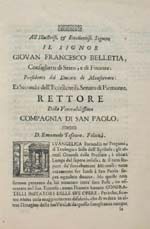Emanuele Tesauro. History of the most venerable Compagnia of the Catholic faith, under the invocation of saint Paul, in the august city of Turin
by Anna Cantaluppi (editor)
In 1657 Emanuele Tesauro, author of the “Cannocchiale aristoletico” (the famous treatise on Baroque style) and influential intellectual and historian of the Savoy court, described, in its “Istoria della venerabilissima Compagnia della fede catolica, sotto invocazione di san Paolo, nell’augusta città di Torino” (History of the most venerable Compagnia of the Catholic faith, under the invocation of Saint Paul, in the august city of Turin), the social and economic role taken on by the Compagnia di San Paolo in the Savoy duchy one hundred years after its foundation.
After an introductory chapter, of a strongly polemic nature, on the Protestant reformation and on the wars of religion in France, the author links the birth of the Compagnia to the rebirth of the Savoy duchy under Emanuele Filiberto and the Catholic reformation promoted by the Council of Trent, stressing its role in the introduction of Jesuits in Turin and in the building of the Santi Martiri Church.
The central chapters describe the main institutions of the Compagnia: the Monte di Pietà (pawnbroking institute), the Casa del Soccorso (institute for the education of poor girls of good family) and the Ufficio Pio (assistance).
The final part is given over to the promotion of initiatives of social interest: the Collegio dei Nobili Convittori (for the education of the sons of the wealthy classes), the Albergo di Virtù (for providing vocational training to beggars) and the Charity Hospital.
Reprinted in 1701 in folio by Zappata, with several additions, the first history of the Compagnia is now reproposed in a modern and commented edition, by Anna Cantaluppi.
The text comes complete with a dual critique key. In the first the bibliographical and archival sources indicated by Tesauro are stated and identified. These were written by Tesauro in succinct notes in the margin of the original text. The second offers the reader lexical and historical notes with short biographical profiles of the numerous brethren cited in the work.
In the Preface Marziano Guglielminetti retraces the work, analysing the contents and style. In the Introduction, after examining the Compagnia’s relationships with the author and with the city, the editor analyses the rhetoric and language of the Istoria, by putting it into the context of Tesauro’s literary production. The analysis of the sources used by the author, from ecclesiastic historians to those of Savoy, from the classics to Bodin, from archive deeds to hand-written memoranda, has allowed some unpublished works to be identified and the highlighting of some interesting links with certain privileged sources. The essay emphasises the importance of the work for understanding the attitude of the society of the ancient régime towards social, religious and economic issues as well as the innovative nature of the Compagnia’s “responses”.
E. Tesauro, Istoria della venerabilissima Compagnia della Fede Catolica, sotto l’invocazione di San Paolo, nell’Augusta città di Torino, Anna Cantaluppi (editor), Torino, 2003.




